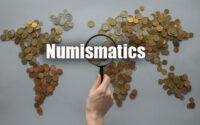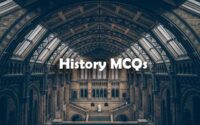Numismatics Quiz
In this Article, we have provided the Numismatics Quiz Question Papers along with Solutions. So, the interested candidates who applied for jobs in Numismatics can download Numismatics Quiz Question Papers for free of cost. Get all the Numismatics Quiz Question Papers with just one click. Click on the enclosed links below to download the Numismatics Quiz Question Papers.

Check the Last five years Numismatics Quiz Question Papers to get a clear idea of the exam pattern. Along with Numismatics Quiz Question Papers, it’s better to refer Numismatics Syllabus & Exam Pattern before starting preparation. So, click on link to check and download Numismatics Quiz Question Papers PDF.
Quiz Question Papers on Numismatics
1. The Tanka and Jital coins were first issued in India by :
(1) Qutubuddin Aibak
(2) Muhammad Bin Tughlaq
(3) Ruknuddin Firozshah
(4) Iitutmish
2. Who among the following historians called Iltutmish as ‘Prince of Moneyers’?
(1) Nelson Wright
(2) Lane Poole
(3) Woolseley Haig
(4) Elphinstone
3. Who among the following Delhi Sultans first inscribed the name of mint on this coins?
(1) Balban
(2) Iltutmish
(3) Muhammad Bin Tughlaqg
(4) Firozshah Tughlaq
4. Who among the following Mughal Emperors issued the Silver Shahrukhi coins?
(1) Babur
(2) Shah Jahan
(3) Aurangzeb
(4) Jahandar Shah
5. Who among the following Delhi Sultans issued Token Currency?
(1) Khizr Khan
(2) Ibrahim Lodi
(3) Muhammad Bin Tughlaqg
(4) Balban
6. How many Behalolis were equal to one Tanka?
(1) 50
(2) 64
(3) 48
(4) 40
7. Who among the following Muslim rulers first issued ‘Rupya’ (Rupee)?
(1) Sher Shah Sun
(2) Islam Shah Sur
(3) Sikandar Shah Sur
(4) Adil Shah Sur
8. Akbar’s square silver rupee was known as
(1) Dogan
(2) Jalali
(3) Fulus
(4) Nisfi
9. In the Mughal period the coins newly issued in the time of a reigning Emperor were known as :
(1) Peet Sikka
(2) Chalam Sikka
(3) Kora Sikka
(4) Khazana Sikka
10. Who among the following Muslim rulers first inscribed inscription in Devanagari script on his coins?
(1) Sher Shah Suri
(2) Iltutmish
(3) Altlauddin Khilji
(4) Qutubuddin Aibak
11. According to Tuzuk-t-Jahangiri in Jahangir’s time the highest silver coin 100 tolas in weight was called?
(1) Kaukab-i-tali
(2) Kaukab-i-Iqbal
(3) Kaukab-i-Bakht
(4) Nur-Mihar
12. During the Mughal period the officer who examined the purity of the coins was known as :
(1) Tahavildar
(2) Sarraf
(3) Daroga
(4) Mushrif
13. During Akbar’s reign how many Dams were equal to one rupee?
(1) 64 dams
(2) 48 dams
(3) 40 dams
(4) 50 dams
14. During the reign of Akbar when Ain-i-Akbari was being compiled what was the ratio in the value of gold to that of Silver?
(1) 14 to 1
(2) 12 to 1
(3) 94 to 1
(4) 16 to 1
15. How many Dams were equal to one rupee during the time of Sher Shah?
(1) 40 dams
(2) 62 dams
(3) 48 dams
(4) 64 dams
16. During the reign of Akbar half of the copper Dam was called :
(1) Adhela
(2) Paola
(3) Damn
(4) Nisari
17. Who among the following Mughal emperors forbade the use of ‘Kalma’ on his coins?
(1) Aurangzeb
(2) Muhammad Shah
(3) Bahadur Shah
(4) Farrukhsiyar
18. Who among the following foreign travellers has given a detailed description of the currency system prevalent in Vijay Nagar Kingdom?
(1) Domingos Paes
(2) Abdur Razak
(3) Nicolo Conti
(4) Barbosa
19. In the Vijay Nagar kingdom the gold coin was known as :
(1) Tar
(2) Varaha
(3) Ashrafi
(4) Muhar
20. Who among the following was a regular officer working in a mint in the Mughal period?
(1) Amin
(2) Amailguzar
(3) Karkun
(4) Bitikchi
| Questions and Answers | GK |
| Quiz | MCQs |
21. In the Mughal period how many damris were equal to one paisa?
(1) Four
(2) Eight
(3) Two
(4) Six
22. The main function of a ‘Tahavildar’ working in a mint during the Mughal Period was to :
(1) Examine the purity of coins
(2) Keep the daily account of the profits of the mint
(3) Maintain the daily account of the mint
(4) Assist the Daroga in general administration of the mint
23. According to S.H. Hodivala the actual weight of a new dam issued by Aurangzeb was :
(1) 215 grain
(2) 195 grain
(3) 190 grain
(4) 217 grain
24. In the time of Akbar how many annas were equal to one silver rupee?
(1) 18 Annas
(2) 16 Annas
(3) 24 Annas
(4) 20 Annas
25. In which of the following Rajput states the ‘Jharshahi’ coins were prevalent?
(1) Jodhpur state
(2) Jaipur state
(3) Bikaner state
(4) Mewar state
26. ‘Dhabbushahi’ coins were prevalent in which of the following Rajput states?
(1) Jodhpur state
(2) Bundi state
(3) Mewar state
(4) Kota state
27. ‘Vijayshahi’ coins were prevalent in the Rajput state of :
(1) Jaipur state
(2) Bikaner state
(3) Jaisalmer state
(4) Jodhpur state
28. In which of the following Rajput states ‘Phadiya’ coin was in use?
(1) Jodhpur state
(2) Mewar state
(3) Bundi state
(4) Dungarpur state
29. The highest gold coin in weight prevalent in Akbar’s time was known as:
(1) Akbarshahi
(2) Jalali
(3) Ilahi
(4) Shahanshahi
30. The rates of exchange of currencies were determined by which of the following factors :
(1) The demand and supply of bullion in a given market at any point of time
(2) The metallic content of a coin
(3) The enormous expertise of fiscal operators like sarrafs to manipulate the complex money market to their own advantage
(4) All the above three factors
31. “Surat alone remitted eleven lakhs of rupees as mint revenue out of the thirty lakhs of its total revenue.” This statement belonged to which one of the following foreign traveller?
(1) William Hawkins
(2) Tavernier
(3) Bernier
(4) Manucci
32. In Jahangir’s time the gold coin quarter in weight of one tola was known as:
(1) Suki
(2) Nurani
(3) Rawazi
(4) Nurjahani
33. Which one of the following officers maintained the daily account of a mint in the Mughal empire?
(1) Tahavildar
(2) Mushrif
(3) Sikkachi
(4) Chasnigir
34. Which one of following was not a member of a mint staff during the Mughal period?
(1) Fotedar
(2) Poddar
(3) Mushrif
(4) Tahavildar
35. Which one of the following statements is not correct about the Mughal mint system?
(1) The most remarkable characteristic of the Mughal mint system was free coinage in the empire
(2) The mughal emperors had kept very strict vigilance over the mint administration
(3) They did not pay great attention to the establishment of several mints in the empire
(4) The mughal emperors issued several coins of different metals, weights and names?
36. How many varieties of gold coins are mentioned in Ain-i-Akbari prevalent in Akbar’s time?
(1) 24
(2) 26
(3) 15
(4) 18
37. ‘Reil’ was silver coin which were-imported in India from abroad during the Mughal period from which country they were imported?
(1) Spain
(2) France
(3) England
(4) Germany
38. At the time of the compilation of Ain-i-Akbarit in 1595 what was the value of a Muhar in Akbar’s time?
(1) Twelve rupees
(2) Fourteen rupees
(3) Nine rupees
(4) Eleven rupees
39. The mints under the Indian Mughal are distinguished into four categories. Which one of the following category of mints was not part of them?
(1) Regular official mints at the central towns of the Empire
(2) Royal camp. mints also known as muaskar-i-iqbal
(3) Miunts of the Rajput states
(4) Temporary mints issuing coins on the occassion of the occupation of a territory or a conquent
40. Tavernier, a French traveller gives the exchange rates of various small coins such as dam, damri, chhadam, adhela, paisa etc. prevalent in the Mughal period. According to him how many damris were equal to one paisa?
(1) Four
(2) Three
(3) Six
(4) Eight
41. Which one of the following places did not have any mint in Akbar’s reign?
(1) Ahmedabad
(2) Asirgarh
(3) Burhanpur
(4) Patna
42. During which one of the following Mughal emperor’s reign the farming system was introduced for the mints?
(1) Farrukhsiyar
(2) Aurangzeb
(3) Bahadur Shah
(4) Shahjahan
43. In the Mughal period the old silver coins which were issued in the reign of former kings were known as :
(1) Peet rupee
(2) Kora sikka
(3) Khazana rupee
(4) Chalani rupee
44. In Mughal period the state revenue was reckoned in :
(1) Chhadam
(2) Tanka
(3) Rupee
(4) Dam
45. Which one of the following coins was not in use in the Mughal period?
(1) Dam
(2) Jital
(3) Rupee
(4) Adhela
46. In Ain-i-Akban two lowest fractional units of Akbar’s silver rupee are mentioned. They were Suki and Kala. How many Kala were equal to one rupee?
(1) 40
(2) 20
(3) 16
(4) 48
47. In Mughal period both for administrative and commercial purpose, the basic unit for all cash transactions was :
(1) Rupee
(2) Dam
(3) Tanka
(4) Jital
48. According to William Hawkins one ashrafi prevalent in Akbar’s reign was equal to :
(1) 10 rupees
(2) 9 rupees
(3) 10.82 rupees
(4) 8 rupees
49. According to Nelson Wright, what was the main cause for introduction of the token currency by Muhammad Bin Tughlaq?
(1) Scarcity of silver
(2) He liked to make new experiments
(3) Conquest of new territories
(4) Financial crisis
50. The lowest fractional unit of the silver rupee mentioned in the Ain-i-Akbari was 1/20 of the rupee. Which was known as :
(1) Kala
(2) Suki
(3) Anna
(4) Sultani



